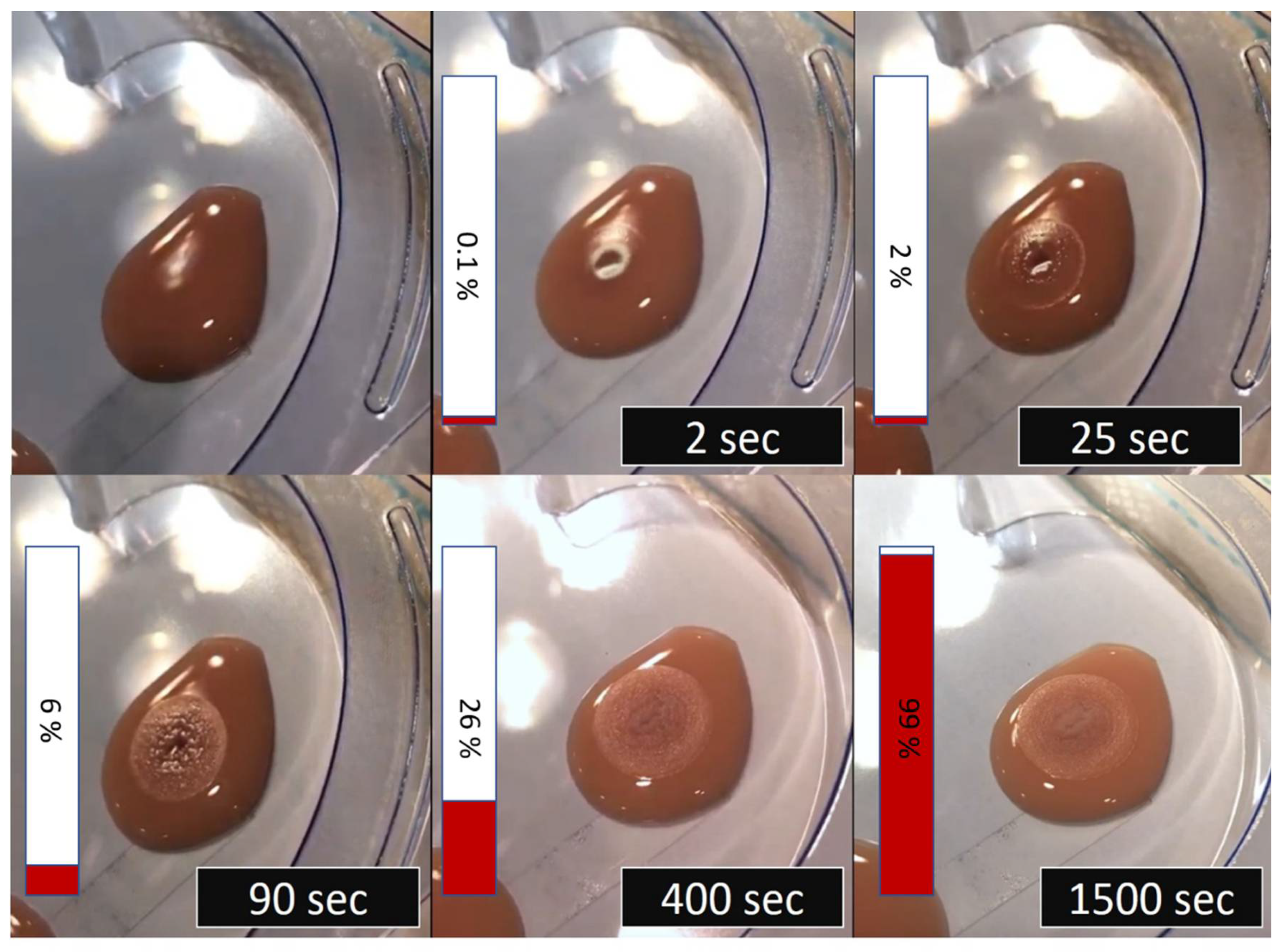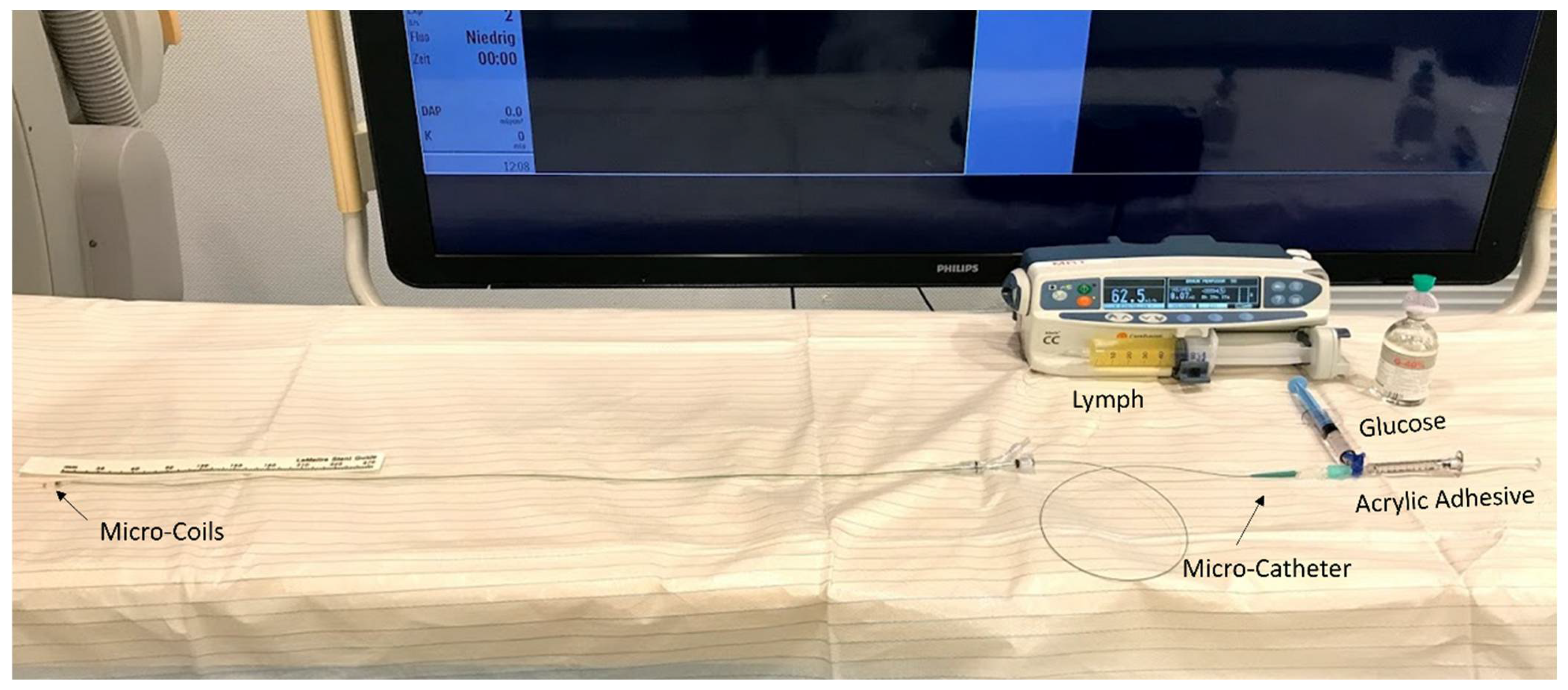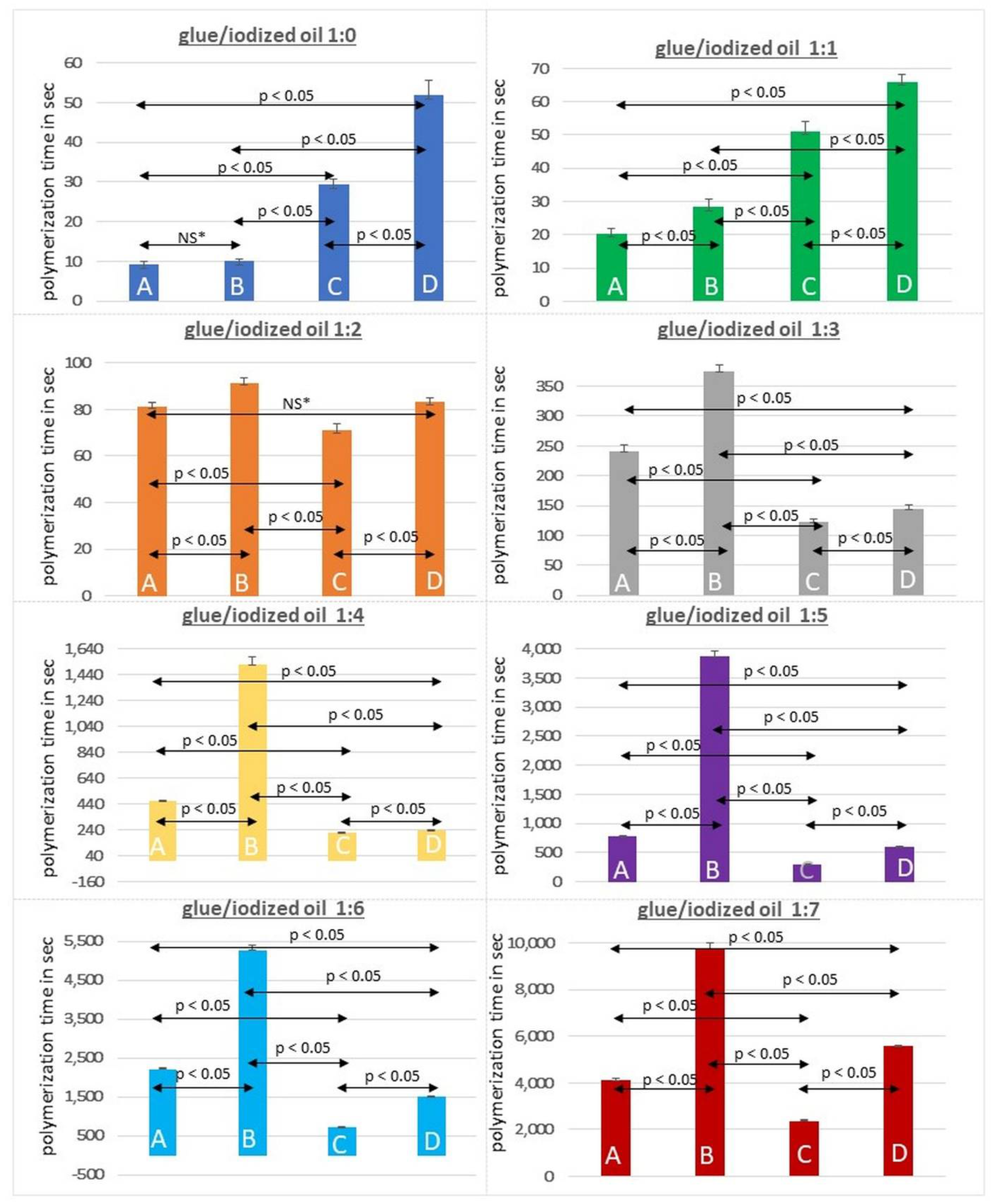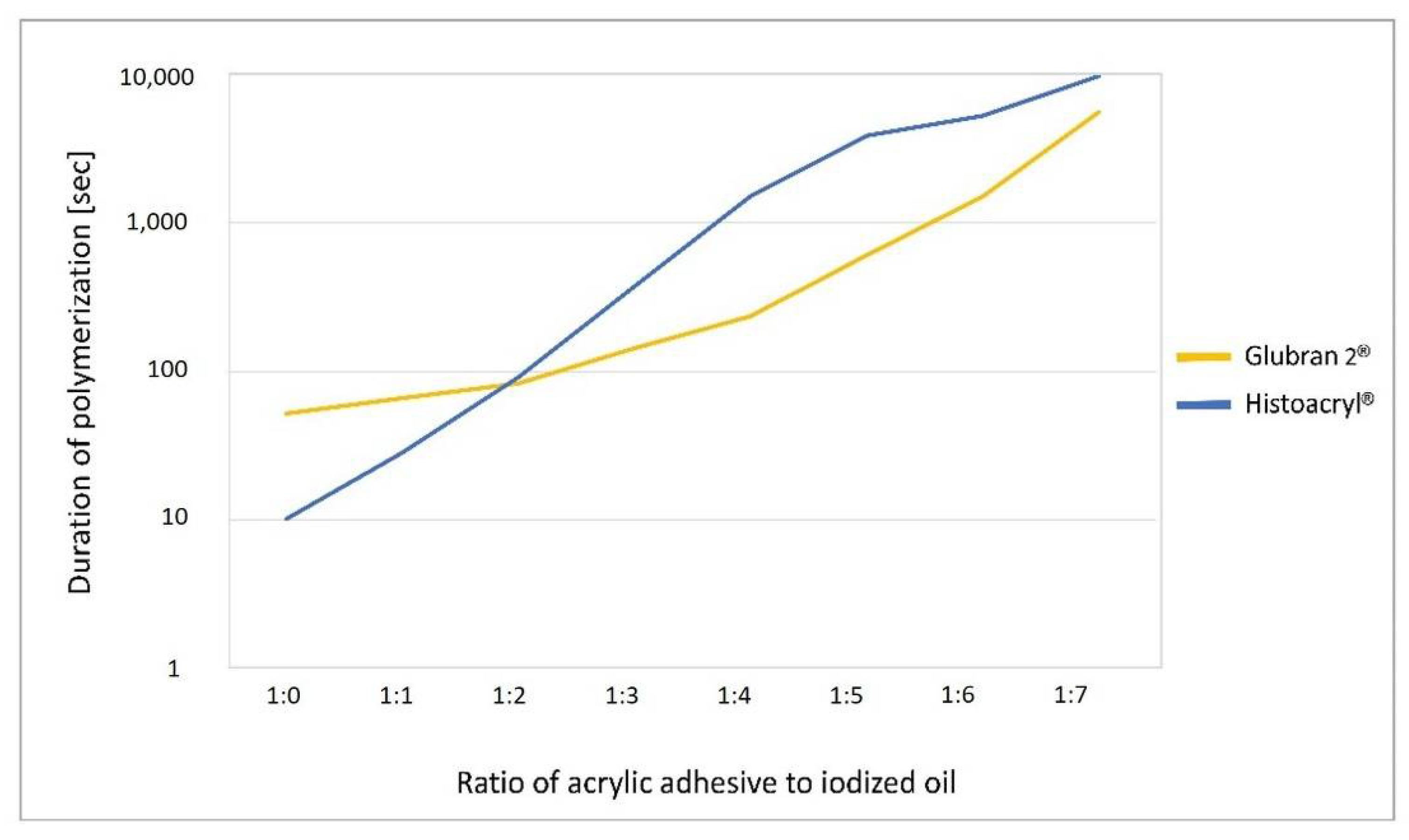In Vitro Evaluation of Acrylic Adhesives in Lymphatic Fluids-Influence of Glue Type and Procedural Parameters
Abstract
1. Introduction
2. Materials and Methods
2.1. Static Analysis of Polymerization Times
- A: HA in low TG;
- B: HA in high TG;
- C: GL in low TG;
- D: GL in high TG.
2.2. Dynamic Analysis of Embolization Times
2.3. Statistical Analysis
3. Results
3.1. Static Polymerization
3.2. Dynamic Embolization
4. Discussion
- Anionic polymerization initiation;
- Zwitterionic polymerization initiation;
- Radical polymerization initiation.
5. Conclusions
Supplementary Materials
Author Contributions
Funding
Institutional Review Board Statement
Informed Consent Statement
Data Availability Statement
Conflicts of Interest
References
- Schild, H.H.; Strassburg, C.P.; Welz, A.; Kalff, J. Treatment options in patients with chylothorax. Dtsch. Ärzteblatt Int. 2013, 110, 819–826. [Google Scholar] [CrossRef]
- Schild, H.H.; Naehle, C.P.; Wilhelm, K.E.; Kuhl, C.K.; Thomas, D.; Meyer, C.; Textor, J.; Strunk, H.; Willinek, W.A.; Pieper, C.C. Lymphatic Interventions for Treatment of Chylothorax. RöFo-Fortschr. Geb. Röntgenstrahlen Bildgeb. Verfahren. 2015, 187, 584–588. [Google Scholar] [CrossRef] [PubMed]
- Pieper, C.C.; Hur, S.; Sommer, C.M.; Nadolski, G.; Maleux, G.; Kim, J.; Itkin, M. Back to the Future: Lipiodol in Lymphography-From Diagnostics to Theranostics. Investig. Radiol. 2019, 54, 600–615. [Google Scholar] [CrossRef]
- Nadolski, G.J.; Itkin, M. Lymphangiography and thoracic duct embolization following unsuccessful thoracic duct ligation: Imaging findings and outcomes. J. Thorac. Cardiovasc. Surg. 2018, 156, 838–843. [Google Scholar] [CrossRef] [PubMed]
- Itkin, M.; Chen, E.H. Thoracic duct embolization. Semin. Interv. Radiol. 2011, 28, 261–266. [Google Scholar] [CrossRef] [PubMed][Green Version]
- Itkin, M.; Kucharczuk, J.C.; Kwak, A.; Trerotola, S.O.; Kaiser, L.R. Nonoperative thoracic duct embolization for traumatic thoracic duct leak: Experience in 109 patients. J. Thorac. Cardiovasc. Surg. 2010, 139, 584–590. [Google Scholar] [CrossRef] [PubMed]
- Chen, E.; Itkin, M. Thoracic duct embolization for chylous leaks. Semin. Interv. Radiol. 2011, 28, 063–074. [Google Scholar] [CrossRef] [PubMed]
- Lewis, S.B.; Srinivasa, R.N.; Shankar, P.R.; Bundy, J.J.; Gemmete, J.J.; Chick, J.F.B. Thoracic Duct Embolization—Value Analysis Using a Time-Driven Activity-Based Costing Approach: A Single Institution Experience. Curr. Probl. Diagn. Radiol. 2020, 49, 42–47. [Google Scholar] [CrossRef]
- Behan, N.; Birkinshaw, C.; Clarke, N. Poly n-butyl cyanoacrylate nanoparticles: A mechanistic study of polymerisation and particle formation. Biomaterials 2001, 22, 1335–1344. [Google Scholar] [CrossRef]
- Li, Y.; Barthès-Biesel, D.; Salsac, A.-V. Polymerization kinetics of n-butyl cyanoacrylate glues used for vascular embolization. J. Mech. Behav. Biomed. Mater. 2017, 69, 307–317. [Google Scholar] [CrossRef]
- Merrigan, B.A.; Winter, D.C.; O’Sullivan, G.C. Chylothorax. Br. J. Surg. 1997, 84, 15–20. [Google Scholar] [PubMed]
- Kuetting, D.; Schild, H.H.; Pieper, C.C. In Vitro Evaluation of the Polymerization Properties of N-Butyl Cyanoacrylate/Iodized Oil Mixtures for Lymphatic Interventions. J. Vasc. Interv. Radiol. 2019, 30, 110–117. [Google Scholar] [CrossRef]
- Li, Y. In Vitro Characterization of Cyanoacrylate Embolic Glues Used for Vascular Embolization. Bachelor’s Thesis, Degree-Granting University, Location of University, 2017. Available online: https://www.theses.fr/2017COMP2351 (accessed on 12 May 2022).
- Takasawa, C.; Seiji, K.; Matsunaga, K.; Matsuhashi, T.; Ohta, M.; Shida, S.; Takase, K.; Takahashi, S. Properties of N-Butyl cyanoacrylate–Iodized oil mixtures for arterial embolization: In vitro and In vivo experiments. J. Vasc. Interv. Radiol. 2012, 23, 1215–1221.e1. [Google Scholar] [CrossRef] [PubMed]
- Schild, H.; Hirner, A. Percutaneous translymphatic thoracic duct embolization for treatment of chylothorax. RöFo-Fortschr. Geb. Röntgenstrahlen Bildgeb. Verfahren. 2001, 173, 580–582. [Google Scholar] [CrossRef] [PubMed]
- Donnelly, E.F.; Johnston, D.S.; Pepper, D.C.; Dunn, D.J. Ionic and zwitterionic polymerization of n-alkyl 2-cyanoacrylates. J. Polym. Sci. Part C Polym. Lett. 1977, 15, 399–405. [Google Scholar] [CrossRef]
- Limouzin, C.; Caviggia, A.; Ganachaud, F.; Hémery, P. Anionic Polymerization of n-Butyl Cyanoacrylate in Emulsion and Miniemulsion. Macromolecules 2003, 36, 667–674. [Google Scholar] [CrossRef]
- Cho, I. New ring-opening polymerizations for copolymers having controlled microstructures. Prog. Polym. Sci. 2000, 25, 1043–1087. [Google Scholar] [CrossRef]
- García, F.; Garcia-Bernabé, A.; Compañ, V.; Díaz-Calleja, R.; Guzman, J.; Riande, E. Relaxation Behavior of Acrylate and Methacrylate Polymers Containing Dioxacyclopentane Rings in the Side Chains. J. Polym. Sci. Part B Polym. Phys. 2001, 39, 286–299. [Google Scholar] [CrossRef]
- Leonardi, M.; Barbara, C.; Simonetti, L.; Giardino, R.; Aldini, N.N.; Fini, M.; Martini, L.; Masetti, L.; Joechler, M.; Roncaroli, F. Glubran 2: A new acrylic glue for neuroradiological endovascular use. Experimental study on animals. Interv. Neuroradiol. J. Peritherapeutic Neuroradiol. Surg. Proced. Relat. Neurosci. 2002, 8, 245–250. [Google Scholar] [CrossRef]
- Leonardi, M.; Cenni, P.; Simonetti, L.; Bozzao, A.; Romano, A.; Bonamini, M.; Fantozzi, L.M.; Fini, G. Glubran 2®:a new acrylic glue for neuroradiological endovascular use: A complementary histological study. Interv. Neuroradiol. J. Peritherapeutic Neuroradiol. Surg. Proced. Relat. Neurosci. 2002, 9, 249–254. [Google Scholar] [CrossRef]
- Levrier, O.; Mekkaoui, C.; Rolland, P.H.; Murphy, K.; Cabrol, P.; Moulin, G.; Bartoli, J.M.; Raybaud, C. Efficacy and low vascular toxicity of embolization with radical versus anionic polymerization of n-butyl-2-cyanoacrylate (NBCA). An experimental study in the swine. J. Neuroradiol. 2003, 30, 95–102. [Google Scholar] [PubMed]
- Staats, B.A.; Ellefson, R.D.; Budahn, L.L.; Dines, D.E.; Prakash, U.B.; Offord, K. The lipoprotein profile of chylous and nonchylous pleural effusions. Mayo Clin. Proc. 1980, 55, 700–704. [Google Scholar]
- Hayashi, S.; Miyazaki, M. Thoracic Duct: Visualization at Nonenhanced MR Lymphography—Initial Experience. Radiology 1999, 212, 598–600. [Google Scholar] [CrossRef] [PubMed]
- Hematti, H.; Mehran, R.J. Anatomy of the Thoracic Duct. Thorac. Surg. Clin. 2011, 21, 229–238. [Google Scholar] [CrossRef]
- Bierman, H.R.; Byron, R.L.; Kelly, K.H.; Gilfillan, R.S.; White, L.P.; Freeman, N.E.; Petrakis, N.L.; Singer, G.; Cordes, F. The characteristics of thoracic duct lymph in man. J. Clin. Investig. 1953, 32, 637–649. [Google Scholar] [CrossRef] [PubMed]
- Pieper, C.C.; Feißt, A.; Meyer, C.; Luetkens, J.; Praktiknjo, M.; Trebicka, J.; Attenberger, U.; Jansen, C. Impact of transjugular intrahepatic portosystemic shunt creation on the central lymphatic system in liver cirrhosis. Sci. Rep. 2021, 11, 7065. [Google Scholar] [CrossRef] [PubMed]




| (a) Dynamic Embolization Duration in Low TG Fluid. | ||||||
|---|---|---|---|---|---|---|
| Flow Rate 62.5 mL/h | Flow Rate 125 mL/h | |||||
| Embolization Duration (Glucose 1 mL) [s] | Embolization Duration (Glucose 2 mL) [s] | Embolization Duration (Glucose 5 mL) [s] | Embolization Duration (Glucose 1 mL) [s] | Embolization Duration (Glucose 2 mL) [s] | Embolization Duration (Glucose 5 mL) [s] | |
| HA 1:1 | 18.5 ± 1.2 | 19 ± 1.3 | 24.5 ± 1.3 | 13 ± 0.6 | 15.5 ± 1.4 | 15 ± 0.9 |
| GL 1:1 | 16.5 ± 0.9 | 17.5 ± 1.9 | 20.5 ± 0.7 | 12 ± 1 | 12 ± 0.7 | 14.5 ± 1 |
| HA 1:3 | 29.5 ± 1.2 | 31 ± 2.4 | 35.5 ± 1.9 | 23 ±1.9 | 26 ± 1.6 | 25 ± 1.6 |
| GL 1:3 | 29 ± 1.1 | 27.5 ± 2.2 | 37.5 ± 1.8 | 21 ± 2.2 | 22 ± 1.3 | 23.5 ± 1.9 |
| HA 1:5 | 41.5 ± 2.1 | 45 ± 3.4 | 52 ± 2.6 | 28.5 ± 1.9 | 27.5 ± 1.9 | 31.5 ± 2.3 |
| GL 1:5 | 39.5 ± 1.7 | 43 ± 3.1 | 52.5 ± 2.5 | 27 ± 1.8 | 27 ± 1.8 | 30 ± 2.5 |
| HA 1:7 | 243 ± 9.8 | 260 ± 11.7 | 289 ± 14.6 | No occlusion | No occlusion | No occlusion |
| GL 1:7 | 189 ± 8.2 | 231 ± 10.8 | 265 ± 12.4 | No occlusion | No occlusion | No occlusion |
| (b) Dynamic Embolization Duration in High TG Fluid. | ||||||
| Flow Rate 62.5 mL/h | Flow Rate 125 mL/h | |||||
| Embolization Duration (Glucose 1 mL) [s] | Embolization Duration (Glucose 2 mL) [s] | Embolization Duration (Glucose 5 mL) [s] | Embolization Duration (Glucose 1 mL) [s] | Embolization Duration (Glucose 2 mL) [s] | Embolization Duration (Glucose 5 mL) [s] | |
| HA 1:1 | 35 ± 1.4 | 38.5 ± 1.5 | 45.5 ± 2.1 | 23 ± 1.1 | 24 ± 1.3 | 36 ± 1.5 |
| GL 1:1 | 26.5 ± 1.2 | 35 ± 1.3 | 41 ± 2.3 | 20 ± 0.8 | 19 ± 0.9 | 28 ± 1.4 |
| HA 1:3 | 37.5 ± 2 | 41 ± 1.7 | 49.5 ± 2.6 | 30 ± 1.3 | 34 ± 1.6 | 41 ± 2.1 |
| GL 1:3 | 30.5 ± 1.7 | 38 ± 1.8 | 40 ± 1.9 | 25 ± 1.4 | 25 ± 1.3 | 28 ± 1.1 |
| HA 1:5 | 45.5 ± 2.1 | 49.5 ± 2.2 | 61 ± 3.2 | 36 ± 2.2 | 41 ± 1.7 | 44 ± 2.5 |
| GL 1:5 | 40 ± 2.2 | 44 ± 2 | 54 ± 2.9 | 28 ± 1.8 | 32 ± 1.2 | 32 ± 1.6 |
| HA 1:7 | No occlusion | No occlusion | No occlusion | No occlusion | No occlusion | No occlusion |
| GL 1:7 | No occlusion | No occlusion | No occlusion | No occlusion | No occlusion | No occlusion |
| (a) Dynamic Embolization Distance in Low TG Fluid. | ||||||
|---|---|---|---|---|---|---|
| Flow Rate 62.5 mL/h | Flow Rate 125 mL/h | |||||
| Embolization Distance (Glucose 1 mL) [cm] | Embolization Distance (Glucose 2 mL) [cm] | Embolization Distance (Glucose 5 mL) [cm] | Embolization Distance (Glucose 1 mL) [cm] | Embolization Distance (Glucose 2 mL) [cm] | Embolization Distance (Glucose 5 mL) [cm] | |
| HA 1:1 | 13.5 ± 1 | 15 ± 1 | 17.5 ± 1 | 16 ± 1 | 18.5 ± 2 | 18 ± 2 |
| GL 1:1 | 10.5 ± 1 | 12.5 ± 1 | 16 ± 1 | 17 ± 1 | 17 ± 1 | 18.5 ± 1 |
| HA 1:3 | 21.5 ± 2 | 26 ± 3 | 32 ± 2 | 29.5 ± 3 | 29 ± 2 | 29.5 ± 3 |
| GL 1:3 | 22.5 ± 1 | 22.5 ± 2 | 28 ± 3 | 27 ± 2 | 27 ± 2 | 32 ± 2 |
| HA 1:5 | 31.5 ± 2 | 36 ± 4 | 45 ± 4 | 36 ± 3 | 37 ± 4 | 41.5 ± 3 |
| GL 1:5 | 28.5 ± 2 | 33.5 ± 4 | 40.5 ± 4 | 37.5 ± 3 | 42.5 ± 5 | 44 ± 3 |
| HA 1:7 | 68 ± 4 | 74 ± 6 | 89 ± 7 | No occlusion | No occlusion | No occlusion |
| GL 1:7 | 41 ± 2 | 58 ± 5 | 78 ± 5 | No occlusion | No occlusion | No occlusion |
| (b) Dynamic Embolization Distance in High TG Fluid. | ||||||
| Flow Rate 62.5 mL/h | Flow Rate 125 mL/h | |||||
| Embolization-Distance (Glucose 1 mL) [cm] | Embolization-Distance (Glucose 2 mL) [cm] | Embolization-Distance (Glucose 5 mL) [cm] | Embolization-Distance (Glucose 1 mL) [cm] | Embolization-Distance (Glucose 2 mL) [cm] | Embolization-Distance (Glucose 5 mL) [cm] | |
| HA 1:1 | 20 ± 1 | 23 ± 2 | 26.5 ± 2 | 28 ± 2 | 26 ± 1 | 32 ± 2 |
| GL 1:1 | 17 ± 1 | 17 ± 1 | 23 ± 1 | 24 ± 1 | 25 ± 2 | 28 ± 2 |
| HA 1:3 | 24 ± 1 | 26 ± 2 | 32 ± 2 | 36 ± 2 | 38 ± 2 | 46 ± 3 |
| GL 1:3 | 18,5 ± 1 | 26 ± 3 | 29 ± 2 | 31.5 ± 2 | 33.5 ± 2 | 36 ± 3 |
| HA 1:5 | 38 ± 3 | 45.5 ± 3 | 52.5 ± 3 | 44 ± 3 | 49 ± 3 | 55 ± 4 |
| GL 1:5 | 40.5 ± 3 | 41 ± 2 | 47 ± 3 | 42 ± 2 | 43 ± 3 | 45 ± 3 |
| HA 1:7 | No occlusion | No occlusion | No occlusion | No occlusion | No occlusion | No occlusion |
| GL 1:7 | No occlusion | No occlusion | No occlusion | No occlusion | No occlusion | No occlusion |
Publisher’s Note: MDPI stays neutral with regard to jurisdictional claims in published maps and institutional affiliations. |
© 2022 by the authors. Licensee MDPI, Basel, Switzerland. This article is an open access article distributed under the terms and conditions of the Creative Commons Attribution (CC BY) license (https://creativecommons.org/licenses/by/4.0/).
Share and Cite
Kuetting, D.; Kupczyk, P.; Dell, T.; Luetkens, J.A.; Meyer, C.; Attenberger, U.I.; Pieper, C.C. In Vitro Evaluation of Acrylic Adhesives in Lymphatic Fluids-Influence of Glue Type and Procedural Parameters. Biomedicines 2022, 10, 1195. https://doi.org/10.3390/biomedicines10051195
Kuetting D, Kupczyk P, Dell T, Luetkens JA, Meyer C, Attenberger UI, Pieper CC. In Vitro Evaluation of Acrylic Adhesives in Lymphatic Fluids-Influence of Glue Type and Procedural Parameters. Biomedicines. 2022; 10(5):1195. https://doi.org/10.3390/biomedicines10051195
Chicago/Turabian StyleKuetting, Daniel, Patrick Kupczyk, Tatjana Dell, Julian A. Luetkens, Carsten Meyer, Ulrike I. Attenberger, and Claus C. Pieper. 2022. "In Vitro Evaluation of Acrylic Adhesives in Lymphatic Fluids-Influence of Glue Type and Procedural Parameters" Biomedicines 10, no. 5: 1195. https://doi.org/10.3390/biomedicines10051195
APA StyleKuetting, D., Kupczyk, P., Dell, T., Luetkens, J. A., Meyer, C., Attenberger, U. I., & Pieper, C. C. (2022). In Vitro Evaluation of Acrylic Adhesives in Lymphatic Fluids-Influence of Glue Type and Procedural Parameters. Biomedicines, 10(5), 1195. https://doi.org/10.3390/biomedicines10051195






